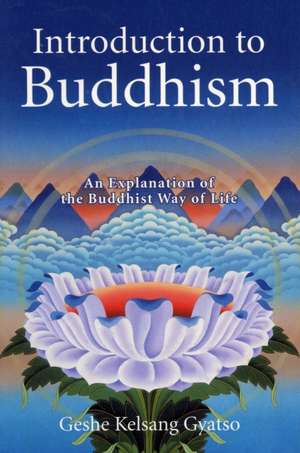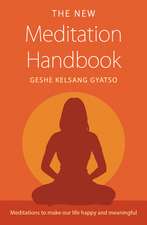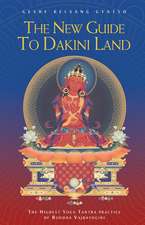Introduction to Buddhism
Autor Geshe Kelsang Gyatsoen Limba Engleză Paperback – apr 2001
| Toate formatele și edițiile | Preț | Express |
|---|---|---|
| Paperback (2) | 75.55 lei 3-5 săpt. | +9.34 lei 7-13 zile |
| Tharpa Publications – apr 2001 | 75.55 lei 3-5 săpt. | +9.34 lei 7-13 zile |
| Tharpa Publications – 31 dec 2007 | 106.59 lei 3-5 săpt. |
Preț: 75.55 lei
Nou
Puncte Express: 113
Preț estimativ în valută:
14.46€ • 15.09$ • 11.96£
14.46€ • 15.09$ • 11.96£
Carte disponibilă
Livrare economică 15-29 martie
Livrare express 01-07 martie pentru 19.33 lei
Preluare comenzi: 021 569.72.76
Specificații
ISBN-13: 9780948006708
ISBN-10: 0948006706
Pagini: 200
Ilustrații: paintings, drawings and photographs
Dimensiuni: 129 x 201 x 13 mm
Greutate: 0.23 kg
Ediția:2 Revised edition
Editura: Tharpa Publications
Locul publicării:United Kingdom
ISBN-10: 0948006706
Pagini: 200
Ilustrații: paintings, drawings and photographs
Dimensiuni: 129 x 201 x 13 mm
Greutate: 0.23 kg
Ediția:2 Revised edition
Editura: Tharpa Publications
Locul publicării:United Kingdom
Cuprins
Contents
PART ONE: Basic Buddhism
Who was Buddha?
Understanding the Mind
Past and Future Lives
What is Karma?
Our Precious Human Life
What is Meditation?
Death
The Buddhist Way of Life
PART TWO: The Path to Liberation
What is Liberation?
Developing Renunciation
The Three Higher Trainings
PART THREE: The Path to Enlightenment
Becoming a Bodhisattva
The Bodhisattva’s Way of Life
Ultimate Truth
Enlightenment
Dedication
Appendix I—The Commitments of Going for Refuge
Appendix II—Liberating Prayer and Mahayana Sutra
PART ONE: Basic Buddhism
Who was Buddha?
Understanding the Mind
Past and Future Lives
What is Karma?
Our Precious Human Life
What is Meditation?
Death
The Buddhist Way of Life
PART TWO: The Path to Liberation
What is Liberation?
Developing Renunciation
The Three Higher Trainings
PART THREE: The Path to Enlightenment
Becoming a Bodhisattva
The Bodhisattva’s Way of Life
Ultimate Truth
Enlightenment
Dedication
Appendix I—The Commitments of Going for Refuge
Appendix II—Liberating Prayer and Mahayana Sutra
of the Three Superior Heaps
Glossary
IndexRecenzii
“Geshe Kelsang Gyatso illuminates the very heart of Buddhist thought and practice.” –Booklist
Geshe Kelsang Gyatso is a highly respected meditation master and scholar of the Mahayana Buddhist tradition.” –Spirituality &Health
“Geshe Kelsang Gyatso has proven to be a popular and accessible authority” –Library Journal
Notă biografică
Geshe Kelsang Gyatso was born in Tibet and is a fully accomplished meditation master and internationally
renowned teacher of Buddhism. Resident in the West since 1977, he is the author of 21 highly acclaimed
books that perfectly transmit the ancient wisdom of Buddhism to our modern world. He has also founded
over 1100 Kadampa Buddhist Centers and groups throughout the world.
renowned teacher of Buddhism. Resident in the West since 1977, he is the author of 21 highly acclaimed
books that perfectly transmit the ancient wisdom of Buddhism to our modern world. He has also founded
over 1100 Kadampa Buddhist Centers and groups throughout the world.
Extras
What is Meditation?
The heart of Dharma practice is meditation. The purpose
of meditation is to make our mind calm and peaceful. If
our mind is peaceful, we will be free from worries and
mental discomfort, and so we will experience true happiness.
But if our mind is not peaceful, we will find it
very difficult to be happy, even if we are living in the very
best conditions. If we train in meditation, our mind will
gradually become more and more peaceful, and we will
experience a purer and purer form of happiness. Eventually,
we will be able to stay happy all the time, even in the most
difficult circumstances.
Usually we find it difficult to control our mind. It seems
as if our mind is like a balloon in the wind—blown here
and there by external circumstances. If things go well, our
mind is happy, but if they go badly, it immediately becomes
unhappy. For example, if we get what we want, such as a
new possession or a new partner, we become excited and
cling to them tightly. However, since we cannot have everything
we want, and since we will inevitably be separated from the
friends and possessions we currently enjoy, this
mental stickiness, or attachment, only causes us pain. On
the other hand, if we do not get what we want, or if we lose
something we like, we become depressed or irritated. For
example, if we are forced to work with a colleague we dislike,
we will probably become irritated and feel aggrieved, with
the result that we will not be able to work with him or her
efficiently and our time at work will become stressful and
unrewarding.
Such fluctuations of mood arise because we are too closely
involved in the external situation. We are like a child making
a sandcastle who is excited when it is first made, but who
becomes upset when it is destroyed by the incoming tide. By
training in meditation, we create an inner space and clarity
that enable us to control our mind regardless of the external
circumstances. Gradually we develop mental equilibrium,
a balanced mind that is happy all the time, rather than an
unbalanced mind that oscillates between the extremes of
excitement and depression.
If we train in meditation systematically, we will eventually
be able to eradicate from our mind the delusions that
are the causes of all our problems and suffering. In this way,
we will come to experience a permanent inner peace, known
as liberation or nirvana. Then, day and night in life after life,
we will experience only peace and happiness.
The heart of Dharma practice is meditation. The purpose
of meditation is to make our mind calm and peaceful. If
our mind is peaceful, we will be free from worries and
mental discomfort, and so we will experience true happiness.
But if our mind is not peaceful, we will find it
very difficult to be happy, even if we are living in the very
best conditions. If we train in meditation, our mind will
gradually become more and more peaceful, and we will
experience a purer and purer form of happiness. Eventually,
we will be able to stay happy all the time, even in the most
difficult circumstances.
Usually we find it difficult to control our mind. It seems
as if our mind is like a balloon in the wind—blown here
and there by external circumstances. If things go well, our
mind is happy, but if they go badly, it immediately becomes
unhappy. For example, if we get what we want, such as a
new possession or a new partner, we become excited and
cling to them tightly. However, since we cannot have everything
we want, and since we will inevitably be separated from the
friends and possessions we currently enjoy, this
mental stickiness, or attachment, only causes us pain. On
the other hand, if we do not get what we want, or if we lose
something we like, we become depressed or irritated. For
example, if we are forced to work with a colleague we dislike,
we will probably become irritated and feel aggrieved, with
the result that we will not be able to work with him or her
efficiently and our time at work will become stressful and
unrewarding.
Such fluctuations of mood arise because we are too closely
involved in the external situation. We are like a child making
a sandcastle who is excited when it is first made, but who
becomes upset when it is destroyed by the incoming tide. By
training in meditation, we create an inner space and clarity
that enable us to control our mind regardless of the external
circumstances. Gradually we develop mental equilibrium,
a balanced mind that is happy all the time, rather than an
unbalanced mind that oscillates between the extremes of
excitement and depression.
If we train in meditation systematically, we will eventually
be able to eradicate from our mind the delusions that
are the causes of all our problems and suffering. In this way,
we will come to experience a permanent inner peace, known
as liberation or nirvana. Then, day and night in life after life,
we will experience only peace and happiness.






